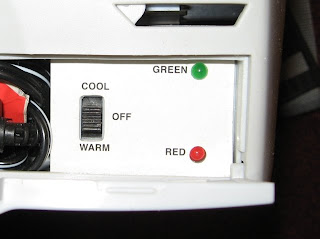But worse than that sort of direct manipulation in advertising is use of the false comparison. Often advertisers not only have to make you want their product, but they have to make you want it more than some competing alternative. Usually this involves explaining why the benefits of one outweigh the other. But there is also a way to "cheat": the false comparison. The latest example I've seen is this photo from a postcard advertising invisalign braces:
 The apparent message in this photo is "invisalign looks better on your teeth than conventional braces." The unspoken, subtle and manipulative implication is "invisalign users have better, smoother skin with no wrinkles or visible pores, their lips are full and glossy pink, and their noses are tinier with smaller nostrils." This is, or course, absurd. But that's the message your brain picks up without you ever being aware of just how bogus the comparison is. All you register consciously is, "wow, the invisalign side really does look much better."
The apparent message in this photo is "invisalign looks better on your teeth than conventional braces." The unspoken, subtle and manipulative implication is "invisalign users have better, smoother skin with no wrinkles or visible pores, their lips are full and glossy pink, and their noses are tinier with smaller nostrils." This is, or course, absurd. But that's the message your brain picks up without you ever being aware of just how bogus the comparison is. All you register consciously is, "wow, the invisalign side really does look much better."If you look for it, you might be surprised how often this trick is used in advertising, particular in "before and after" photos. But it usually only shows up in professionally produced mass advertising. Many small businesses and small web sites will run very reasonable photos of "this is what it looked like when we started" and "this is what it looked like when we finished." But the cost of mass mailings or print ads is so high that advertising firms have to do anything they can to improve the success rate for their client, to justify selling them more advertising.
This technique feels sleazy to me, and makes me dislike products that use it. And it's not even necessary. I think invisalign is a great product. But the use of this false comparison technique actually makes me think poorly of the company and, by extension, what they are selling. I suspect that's not the perception they were hoping to buy with their advertising dollars.

